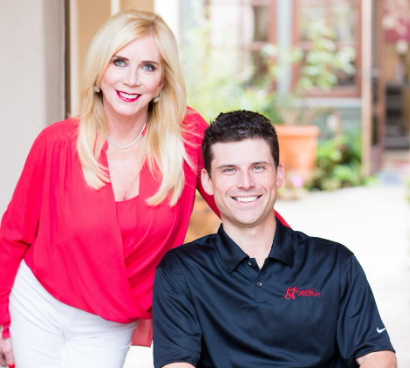Advocating for Access: Overcoming Insurance Limitations for Spinal Cord Injury Rehabilitation
By Micki Purcell, President & Founder — Walking With Anthony
A split-second car crash, a careless misstep, a senseless act of violence, a horrifying sports injury, or a surgical mistake could change your life forever. In the US alone, around 17,000 people suffer spinal cord injuries every year. Approximately 282,000 Americans are attempting to recover from spinal cord injuries, but most remain trapped in wheelchairs.
Though proven therapies and solutions exist, they remain out of reach for a majority of survivors. The high cost of freeing one person from a wheelchair prompts medical professionals to tell tens of thousands of patients that they will never walk again. We are here to say there is hope and to expand access to the life-altering treatments these people need.

Our first-hand introduction to insurance gaps for spinal cord injury survivors
On February 6, 2010, I received the earth-shattering news that my son, Anthony, misjudged a dive off Miami Beach. The moment his head slammed into the sand bar, he broke his neck, bruised his C5 and C6 vertebrae, and injured his spinal cord.
Six weeks in the hospital and 20 days of rehab passed in a blur of emotions and extensive surgeries. Before Anthony could even support himself in a wheelchair, someone on the staff tapped me on the shoulder to let me know our insurance coverage had run out. I learned our time in rehab was over 24 hours before the doors slammed behind us.
We pulled together $40,000 for two more months of treatment. After that, we scraped together $50,000 to cover a year of outpatient rehab sessions from a facility in California. Even with this outstanding therapy, Anthony struggled with depression and hopelessness.
Realizing Anthony’s lack of hope and purpose was just as dangerous as his physical condition, I challenged him to make a difference in the lives of others by raising awareness. As my son reached out, his mental outlook improved. Day by day, his gains in mental wellness brought new physical achievements.
Today, Anthony has regained the use of his entire upper body. He benches 120 pounds, works out every day, and recently became a proud new father. He is redefining spinal cord injury recovery and showing doctors and patients alike what is possible.
Why the lack of insurance for spinal cord injuries is so prevalent
Our case is not the exception; it is the norm. Standard insurance, even excellent insurance, does not cover the rehab spinal cord injury survivors need.
The average person with a spinal cord injury cannot expect insurance to cover a year — or even a month — of rehab. Most receive around 12 days in a dedicated rehab facility.
While insurance covers treatment for a broken back, it does not cover a spinal cord injury because many in the medical world believe that while a bone will heal, a spinal injury will not. Still, this was not true in Anthony’s case, and it does not need to be true in thousands of others. There is hope. That is the message we want to share.
How treatments left uncovered by insurance impact spinal cord injury survivors and their families
Spinal cord injury survivors lose the use of their legs, and possibly their arms and hands. They face the daunting realization that they must relearn how to do everything, from brushing their teeth to consciously managing their body temperature.
In many cases, they lose their livelihood, and their income drops below the poverty line. In this community, depression is pervasive.
It takes approximately $100,000 to fund the rehab, equipment, and care one person needs each year, but rehab is only the tip of the iceberg. To regain independence, spinal cord injury survivors need wheelchair-accessible vans and homes. In the beginning, they need 24/7 care.
The lack of coverage affects everyone in the family. When these survivors return home, their needs are similar to those of newborns. Someone has to be there around the clock to feed them, bathe them, and help them use the restroom. Insurance does not cover the cost of a wheelchair or the weeks of in-home care that could help families transition.
I often think of one young man our foundation tried to help, named Michael. To cover his expenses, his single mother was forced to go to work, leaving her son in bed alone day after day. Sadly, he eventually gave in to hopelessness and committed suicide. We, unfortunately, see dozens of cases like Michael’s, but with proper treatment, each one could have had a different ending.
Raising awareness about the need for greater insurance coverage
I am committed to educating people about the life-changing possibilities insurance coverage can offer injury survivors. I refused to accept the diagnosis of paralysis for my son, and I refuse to accept it for the thousands upon thousands of people who suffer spinal cord injuries each year.
For example, our foundation helped a spinal cord injury survivor named Sean, whose injury left him paralyzed for months. Today, he’s taking his first steps on his own.
Recovery through rehab requires intense effort, but it is still attainable. Groundbreaking treatments are available, and fortunately, Sean’s parents had the money to pay for them out of pocket. Some survivors try to fund treatments by launching GoFundMe accounts while others take mortgages out on their homes, but the reality is that most eventually give up on recovery.
I want insurance companies to realize that spinal cord injury survivors can reclaim their lives and become healthy, strong, and independent again. When I brought Anthony home, he couldn’t brush his own teeth, but today, he’s arguably even stronger than he was before his accident.
When doctors told me Anthony would be paralyzed, I never believed them. Today, we are living proof that paralysis is a hurdle to clear, not a label to accept. Join us as we educate people in the medical and insurance industries about the effectiveness of rehabilitation, and help thousands of other survivors clear that hurdle.
Author: Rohan Singh














